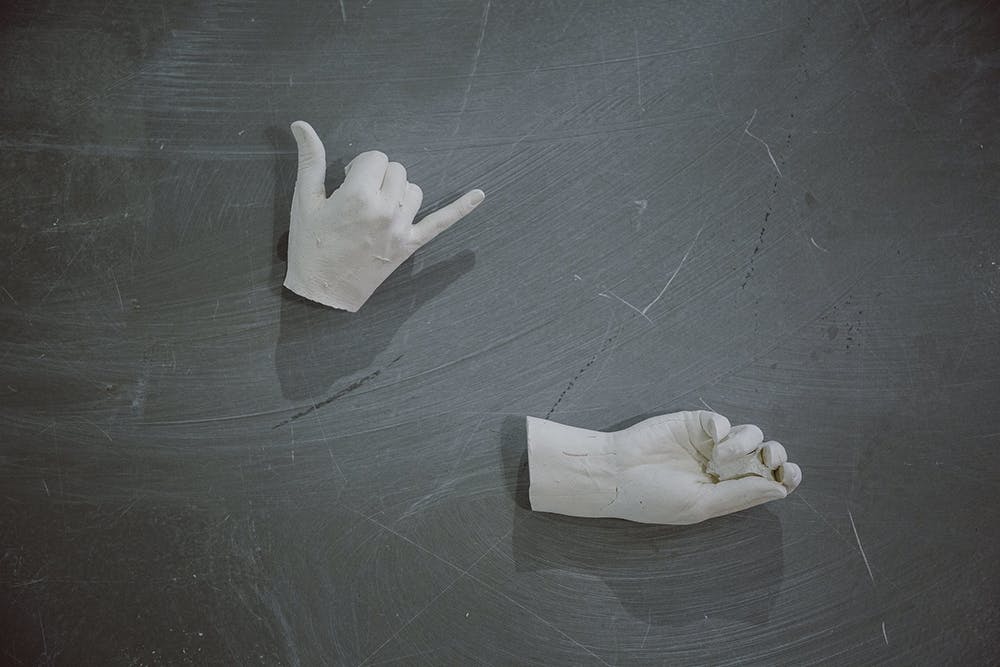Latest News
Essay on Eleanor Duffin's show 'A Phantom Limb' by Lauren Houlton
Thursday, 27 February, 2020 — Writer and curator Lauren Houlton writes an essay on Eleanor Duffin's show 'A Phantom Limb' in The Gallery at Plymouth College of Art.
<p>‘Nothing starts at the beginning, not really’, opens B. Ruby Rich’s<em> New Queer Cinema </em>(2013). ‘The first chapter of every book already has a backstory, every birth its conception myth, every decade the shadow of the one before it’. In beginning to map the designation of a new cinematic genre composed of LGBTQ+ filmmakers, Rich acknowledges its predecessors and the traces of their works that either explicitly or implicitly, leave a mark long after their original release. Production does not take place in isolation.<br /></p>
Photos by Luke Frost
<p>Eleanor Duffin writes letters to Barbara Hepworth, aware that these will not be read by the addressed recipient. In one, which she reads to me in her studio, she pinpoints the moment in which she first became interested in Hepworth, when she visited The Barbara Hepworth Museum and Sculpture Garden in St Ives, Cornwall, a preservation of her studio where she lived and worked from 1949 until her death in 1975. Having been aware of her work, unavoidable due to her canonical status in art history, Duffin relays her surprise at being overcome with emotion during her visit and the affinity that she felt for Hepworth when seeing the remains of her working life - tools, sketchbooks, and work clothes - for the first time. She segments these letters into chapters; this one named <em>The Phantom Limb</em>, is also the title of her installation at the Gallery at Plymouth College of Art.<br /></p>
Photos by Luke Frost
<p>One could situate Duffin’s interest in Hepworth, and her ongoing, year-long practice of writing to her, as an example of an affective connection, and tactile, embodied way of relating to history. Duffin’s desire to reach out to Hepworth through this intimate mode of communication illustrates a closeness, a bond, which reaches across time. These attempts at dialogue are knowingly futile; the address always one-sided. Desire and loss coincide, but what is no longer immediate is nonetheless still a part of living in the present. Duffin’s work captures this urge to get close to, or even solidify, these residues of those who came before us and enliven them through these emotive encounters.</p>
<p>In the many documentaries made about Hepworth, Duffin noticed a recurring tendency of the camera operator to focus on her hands while at work. This is likely to stress a progenitive link between the maker and the object; witnessing her at work, watching her hands in motion, confirms her authorship of these carved stone, rock, and marble artworks. To reflect this, Duffin has produced a series of screen prints and sculptural casts of hands fixed in the midst of a range of gestures. Hands connote touch, implying a physicality. In her influential book, <em>Getting Medieval</em> (1999) Carolyn Dinshaw uses the metaphor of touch to imagine how different historical moments can overlap. ‘I locate it rather in his desire, which I call queer, like mine - for partial, affective connotation for community or even, touch across time’ she writes, aligning an identification with a historical moment or figure with a drive for physical closeness. If Duffin’s continual return to Hepworth can be viewed this way too, can her casting and screen printing of hands be viewed as an attempt to grasp, or to touch, a historical moment?<br /></p>
Photos by Luke Frost
<p>This sentiment extends into a short, Super 8 film which plays inside a temporary corridor inside the gallery space. It presents Duffin and dance artist, Claire Daly, attempting to learn the hand gestures performed by Yvonne Rainer in her 1966 film, <em>Hand Movie.</em> Rainer’s piece, filmed with fellow Judson Church artist William Davis whilst confined to a hospital bed, shows a framed hand held upright engaged in a series of simple gestures. By re-staging Rainer’s movements in collaboration with a female friend, Duffin situates herself within a capacious network of relations. It is a generative act, inserting herself into bodily motions from the past whilst in dialogue with peers invested in their own creative practices in the present.<br /></p>
Photos by Luke Frost
<p>‘Living a feminist life creates feminist things. We all have tendencies; we might be a feminist hoarder, keep every little poster, button, scrap of paper from a meeting; or we might not’ writes Sara Ahmed in <em>Living a Feminist Life</em> (2017). ‘We need to have things too; things that gather around, reminders of a feminist life, happy objects even, reminders of connections, shared struggles, shared lives. We might have more or fewer things, but a feminist needs her things’. Keeping mementos, surrounding oneself with feminist material, can be a source of comfort and joy, especially when living life as a ‘feminist killjoy’ often involves arduous questioning, refusal, and struggle against structural inequality. <em>The Phantom Limb </em>is an assemblage of feminist sources calibrated to reflect Duffin’s overlapping influences. Fabrics that echo Hepworth’s studio are draped across the walls and windows and fragment the space. The peach, for instance, is the same as one of Hepworth’s workwear jackets that hang on a hook alongside other stained overalls. The combination of block colours and sheer fabrics fragment, obscure, and reveal aspects of the installation. Along with domestic houseplants (another prominent feature inside Hepworth’s studio) their incorporation brings the softness of the studio into the gallery, whilst referencing thinking around memory and remembrance. Memories, over time, become less immediate, some fade as others remain in sharp focus. Together they compose a welcoming, environment for reflecting on feminist kinship, community and support. These traces have an agency of their own. To reiterate Ahmed on the power of feminist materials: ‘I feel propelled by their kick’.</p>
<p><strong>Words by <a href="https://twitter.com/laurenhoulton?lang=en" target="_blank" rel="noreferrer noopener">Lauren Houlton</a></strong><br /><strong>Photos by <a href="https://www.captainfrostphoto.com/" target="_blank" rel="noreferrer noopener">Luke Frost</a></strong></p>
